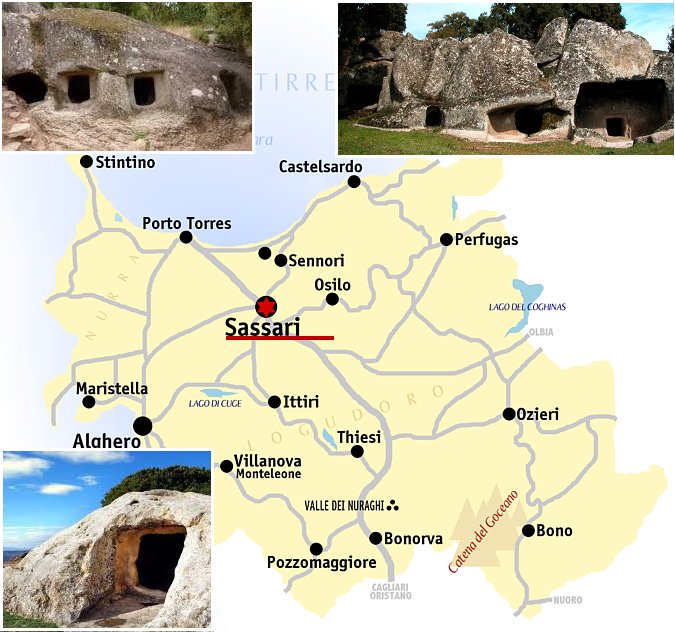A. Sutherland – AncientPages.com – Sardinia is one of the most ancient pieces of land in Europe with a rich legacy of prehistoric monuments. On the island, there are between 8,000 and 10,000 remains from the Nuraghi period (1900 and 730 BC) including circular guard towers, buildings, and cemeteries.
There are also prehistoric monuments called the ‘Domus de Janas’ (‘fairy houses’) or (“di gianas” (‘witches’ houses’), developed by a pre-Nuraghi culture of Ozieri, which flourished between 4000 BC and 3000 BC (or c. 3200 to 2800 BC. People of the Ozieri culture were busy with agriculture, sheep farming, stones- and metalworking.

More than one thousand ‘Domus de Janas’ tombs are scattered all over the island but most of them (about 480) are located in the province of Sᴀssari, in northern Sardinia. However, this kind of ancient tombs, related to Sardinia, is only one of many that can be encountered on the island.
The ‘Domus de Janas’ tombs consist of rock-cut hypogeous structures, which were built underground or in rock faces. The largest of them is the Necropolis of Anghelu Ruju, in Alghero with funeral caves decorated with a light coat of red paint and stylized bull’s heads, which are symbols of male fertility that represent the continuity of life. It is believed that the largest example, known as the Necropolis of Anghelu Ruju (with 38 tombs) that represents the pre-Nuragic style and tradition before the Nuragic civilization flourished on the island.
Based on archaeological findings reported from Sardinia excavations, it is important to emphasize that unique tools, evidence of metal-working, and objects discovered in individual huts of the Ozieri, suggest the culture was well organized and specialized.
Probably, the largest and most elaborate tombs with a monumental appearance belonged to chiefs or other prominent figures, and in this way, the structures bear resemblance to those, in Crete.

The Necropolis of Anghelu Ruju was discovered accidentally in 1903 and contains more than 12 separate complexes of graves dated back to 3300-2900 BC. Excavations exposed the remains of the ᴅᴇᴀᴅ, including those who were embalmed or cremated.
Carved into the granite rocks (less in limestone or basalt), the tombs consist of one or multiple, adjacent, circular rooms which are all connected by a central room. In their structure, they imitate ordinary homes decorated with columns, wood door frames, roof beams, alcoves, seats, and a religious symbol in form of false doors that signaled a pᴀssageway to the beyond.

The interior of the discovered chambers can vary from that of a rounded hut with a conical or triangular ceiling. The walls were usually decorated with reliefs showing the head of a bull or spirals that would symbolize the Mother Goddess and other religious symbols such as bull’s horns and protomes (representing the foremost or upper part of this animal), a symbol of Taurus, who was believed to protect the sleep of the deceased.

The so-called Bucrania (the skull of an ox) sculpted in relief placed above the entrance to a subterranean tomb dated to Ozieri Culture of Sardinia (4,000 BC – Alghero, Sᴀssari, Sardinia). Image credit: Marija Gimbutas
In Sardinia, there have been identified 116 rock-cut tombs with their walls covered with bucrania (depictions of cattle head and horns), which have long been considered as representations of a bull-like divinity. In old European art, the symbolic life energy, rising from the cow’s or bull’s head or sacred horns, represents reborn new life.
Other decorations of the walls include reliefs or etchings depicting magical and religious symbols such as spirals, and zig-zag motifs. A large number of funeral goods included vases, figurines, necklaces, utensils from daily life, and weapons, were found inside the chambers.
This ancient tradition testifies that ancient people of Sardinia believed in life after death and the resurrection of the ᴅᴇᴀᴅ. Death was viewed as a limitless sleep – an eternal sleep.
Written by – A. Sutherland – AncientPages.com Senior Staff Writer
Copyright © AncientPages.com All rights reserved. This material may not be published, broadcast, rewritten or redistributed in whole or part without the express written permission of AncientPages.com
Expand for references
References:
Sardegna.com
Provincia del medio Campidano





